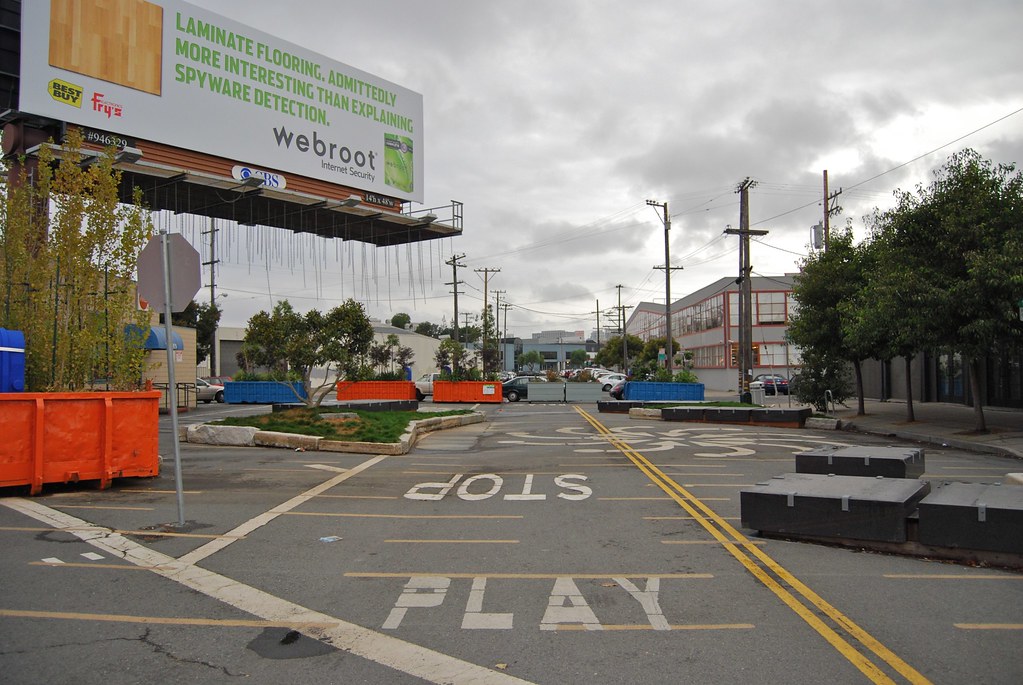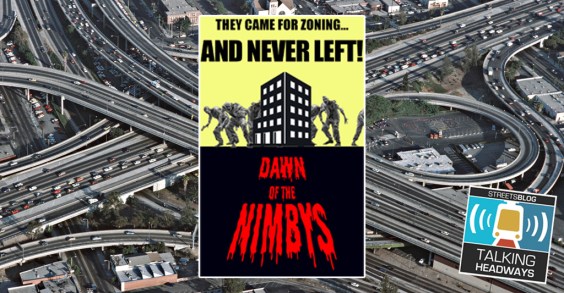When it comes to reclaiming street space for people, San Francisco's Pavement to Parks program has paved the way with a national model showing how cities can embrace community-driven parklet projects. But when it comes to installing plazas, there seems to have been little movement since the first handful were created on "excess" road space in the program's first year. Advocates and some city officials say the program needs to become a greater priority for city leaders.
Since the multi-agency Pavement to Parks was launched in mid-2009, 38 parklets have been installed through its permitting program, including the two-block Powell Street Promenade. Five plazas were also installed using temporary materials at a rapid clip in the program's first year, under then-Mayor Gavin Newsom. Since then, however, no new plazas have been installed, only a few projects are in the pipeline, and the program has made little headway in developing a system for long-term maintenance and permanent upgrades.
"The Pavement to Parks initiative has proven very effective in adding a touch of grace to the public realm, and in changing the perception of our streets as not just places for automobiles but as rightful places for people," said David Alambaugh, manager of the Planning Department's City Design Group. "The program has met with very strong popular support. There is strong interest in seeing the program continue and thrive, and to take on new issues and new challenges."
But the program "has managed to succeed with only modest support from the city," he said. "If it is to thrive and to be successful, and especially if it is to be expanded to take on new challenges, it will need strong, formal funding and strong political support."
Whether that leadership will come from Mayor Ed Lee, however, is unclear. When Streetsblog asked the mayor if he plans to support the expansion of Pavement to Parks plaza projects, his response wasn't quite a full-throated "yes." Plaza projects "take a long time," he said, "because we want it to really be embraced by the neighborhoods, and we have to spend that quality time to make sure everything we do is embraced by those communities."
Advocates compare the state of Pavement to Parks to the ongoing expansion of plazas in New York City, where, under Mayor Michael Bloomberg's administration, dozens of public space expansions in neighborhoods around the city have been implemented over the past few years. That includes Times Square, where plans for a physically permanent plaza are already underway.
"I am fortunate to work for a mayor who has unbelievable political courage," said NYC Transportation Commissioner Janette Sadik-Khan yesterday evening, when she spoke at the SF Bicycle Coalition's Golden Wheel Awards, eliciting applause from her San Franciscan audience.
"They've been innovating beyond just the initial figuring out ways to quickly get things down and test things out," said Kit Hodge, the SFBC's deputy director, former director of the SF Great Streets Project, and co-founder of the NYC Streets Renaissance Campaign. "They've recently been innovating with management tools and collaborations to look at ways to have better longer-term maintenance and management of plazas."
"Strong political leadership was a big part of the reason [the Pavement to Parks] program got off the ground to begin with," added Hodge, "but that's a hard thing to sustain over time. In thinking about the future of the program, we have to take a hard look at the most effective path forward, and what the goals are that we're striving for with this program."
Jane Warner Plaza -- the first Pavement to Parks plaza, installed at 17th and Castro Streets -- has received upgrades with concrete planters, and is the only plaza where permanent improvements are planned, due to Prop B bond funds being set aside for the Castro streetscape project at the behest of D8 Supervisor Scott Wiener. In the Excelsior, Naples Green was installed with "semi-permanent" materials, but it's unknown if there are any plans to upgrade it.
But unlike NYC, SF doesn't assign staff to maintain plazas which lack a community benefit district to care for them, according to Hodge. Showplace Triangle, a plaza installed in lower Potrero Hill in late 2009 using temporary materials, was removed by the Department of Public Works in January because a building development planned for the site is expected to bring a permanent plaza in late 2015, but it had fallen into disrepair. At Guererro Park at San Jose and Guererro Streets, we've heard similar reports of neglect, and there are no known plans for permanent improvements.
Pavement to Parks is developing plans for a plaza known as Persia Triangle, located at Persia and Ocean Avenues at Mission Street in the Excelsior. Other planned projects include a pedestrianized Annie Alley in SoMa and a plaza of unknown size on the east end of Oak Street between Van Ness and Franklin. The program's website also lists plans for "tactical interventions" at the N-Judah's western turnaround in the Outer Sunset and an undetermined location on Polk Street, as part of the SFMTA's planned improvements there. Construction dates for those projects are so far unknown.
SF Municipal Transportation Agency Director Ed Reiskin, who was the director of DPW during Pavement to Parks' first two years, attributed the slowdown of plaza expansions to a lack of street space deemed as "excess roadway" -- or, in other words, low-hanging fruit. "In terms of trying to find dead space and activate it, in the way we did at Castro and 17th, I'm not sure that there are that many great candidates," he told Streetsblog.
Reiskin also thinks the popularity of parklets also "took the momentum" of Pavement to Parks' plaza efforts. "That is continuing to be on fire," he said. "I feel like the momentum shifted towards something that fits us a little better" than NYC.
But Supervisor Wiener, who spearheaded a city deal approved this month to purchase a parking lot in Noe Valley for conversion into a town square, thinks Pavement to Parks has "lost some of its gas" because the city hasn't dedicated a stream of funding to it. "We need to invest in it significantly, and start prioritizing it more in the budget," he said. "The city has always taken the attitude that it should be funded by grants, and that was fine to get it started."
"But if we're serious about creating new public space, which we should be, we need to start funding it out of the city budget."






